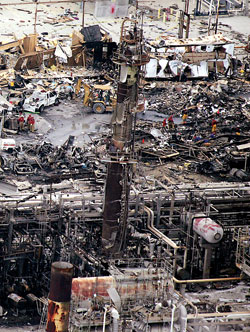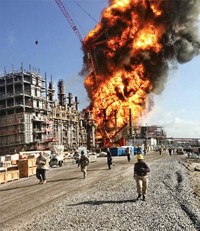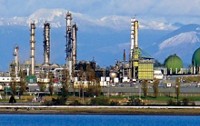Advertisement
Grab your lab coat. Let's get started
Welcome!
Welcome!
Create an account below to get 6 C&EN articles per month, receive newsletters and more - all free.
It seems this is your first time logging in online. Please enter the following information to continue.
As an ACS member you automatically get access to this site. All we need is few more details to create your reading experience.
Not you? Sign in with a different account.
Not you? Sign in with a different account.
ERROR 1
ERROR 1
ERROR 2
ERROR 2
ERROR 2
ERROR 2
ERROR 2
Password and Confirm password must match.
If you have an ACS member number, please enter it here so we can link this account to your membership. (optional)
ERROR 2
ACS values your privacy. By submitting your information, you are gaining access to C&EN and subscribing to our weekly newsletter. We use the information you provide to make your reading experience better, and we will never sell your data to third party members.
Safety
BP Admits Safety Lapses
Company will spend $1 billion to improve safety at Texas City refinery after fatal explosion
by Glenn Hess
December 9, 2005

BP Products North America Inc. said Friday that it would invest about $1 billion over the next five years to improve safety at its Texas City, Texas, refinery after acknowledging that serious management lapses were largely to blame for the explosion and fire that killed 15 employees and injured more than 170 others at the site in March.
In a final report, BP said its investigation team had found “no evidence of anyone consciously or intentionally taking actions or decisions that put others at risk” in the blast. However, “the team found many areas where procedures, policies, and expected behaviors were not met.”
Investigators said the absence of key personnel, confusion around who was in charge, and the behavior of supervisory personnel eroded the chain of command to the point that decision-making authority was unclear. In addition, process safety, operations performance, and systematic risk reduction priorities had not been set and consistently reinforced by management.
“We accept the findings, and we are working to make Texas City a complex that attains the highest levels of safety, reliability, and environmental performance,” said Ross Pillari, president of BP Products North America.
The accident occurred when workers restarting an octane-enhancement isomerization unit overfilled and overheated it, causing the unit to overflow. Workers died because construction trailers were placed too close to the equipment, according to investigators.
The company said it would install modern process control systems on major units, transition to an improved maintenance management system, enhance worker training, and implement other recommendations contained in the final report.
A special project team will also develop plans for reconfiguring and simplifying the operation of the Texas City refinery. “The result will be a safe, reliable, and highly efficient refinery capable of producing clean fuels that consumers are demanding,” site manager Colin Maclean said.
Carolyn W. Merritt, chair of the U.S. Chemical Safety & Hazard Investigation Board, called BP’s report “a sober look in the mirror that reveals an ineffective safety culture at the Texas City refinery.”
Advertisement
BP’s facility at Texas City, about 40 miles south of Houston, is the third-largest U.S. refinery behind ExxonMobil’s plants in Baytown, Texas, and Baton Rouge, La.






Join the conversation
Contact the reporter
Submit a Letter to the Editor for publication
Engage with us on Twitter